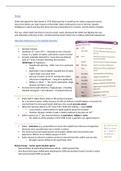Class notes
AQA A Level History Depth Study Notes - Russia: The Great Patriotic War
- Course
- Institution
Extremely high quality and detailed notes on the Great Patriotic War as part of the AQA A Level Depth Study. Notes cover/include: - Operation Barbarossa & The Stalinist Reaction - The Course of the War - The USSR Under Occupation & The Fight Back - The Soviet War Economy - The Defeat of t...
[Show more]



